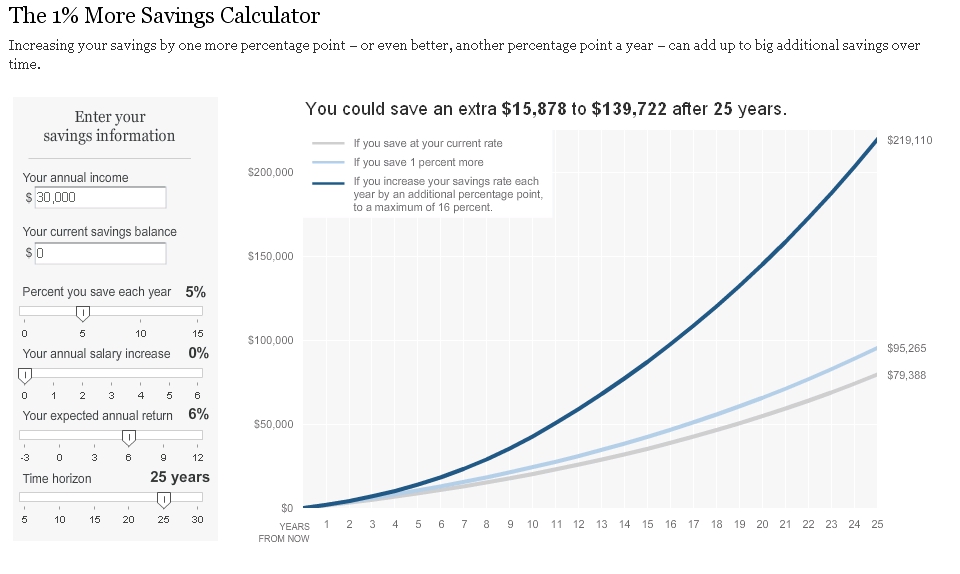Why You Should Save 1% More Each Year
In order to retire with a healthy amount of savings, you are going to have to save close to 15-20% of your income each year. For many of us, this is hard, if not impossible, to do. But there is a solution out there that can help you painlessly reach that level of savings. For the more aggressive people out there, I’ve already laid out a plan called burst savings. This plan has you save very large amounts of your income each year over a shorter period of time. If this is too aggressive for you, I offer the 1% solution.
Whatever you are currently saving, make it a goal of increasing that amount by 1% each year. This should not be difficult to do. If you get a raise at work, say 3%, treat it as though it was 2% and save that 1%. While this amount does not seem as though it adds up, with time on your side, saving 1% more does add up nicely.
Not Saving More
The gray line in the chart below shows how much money you will have in 25 years assuming you earn $30,000 per year and save 5%. It assumes you earn 6% per year and that inflation runs at 3% annually. Finally, it assumes you do not receive a raise at all, so you are consistently saving the same amount each year.
As you can see, in 25 years, you will have saved a little more than $79,000. This is a nice little sum of money, but it can easily be more. Let’s take the same facts from above, but assume that you increase your savings by 1% each year. Your savings will max out at 16% per year. (This means that once you are saving 16%, you will not save 17% the following year, but will continue to save 16% each year thereafter). Again, this does not take into account any increases in income.
As you can see, saving just 1% more each year for 25 years increases the size of your nest egg to $219,100. That is an increase of close to $140,000! This is highlighted by the blue line in the chart above.
Saving More and Earning More
Now the real fun begins. Let’s assume the same facts as above ($30,000 annual salary, saving 5% per year with a return of 6% annually for 25 years. Inflation is 3%.) But now you receive a 3% raise each year and save an additional 1% each year. Note that your savings rate maxes out at 16% again. After 25 years, you have saved over $332,000! That is a nice amount of money.
Final Thoughts
I hope you can see what impact saving just 1% more each year has on your savings. It doesn’t seem like a lot of money and in reality it isn’t. But when you factor time and compound interest into the equation, that small amount of money goes to work for you and in time, you will reap the benefits of it. I urge you to try out the 1% more savings calculator from the New York Times where you can play around with savings amounts, returns and time horizons to get a better feel for how much an extra 1% adds up to.






@Don – While I agree with your initial assessment of the facts, the one thing that I see is that there is a “plan” and there is reality. Depending on your life style, and ability to handle risk, etc. you can do this a lot of ways. I cannot plan on an income, and 3% raise a year, etc. I have never gotten a 3% annual raise consistently. I have gotten a 30% raise, a 15% raise, and then none for 10 years, and am currently unemployed. While I am not poo pooing your idea, I just want to point out that everything is great in practice, but reality is a different beast. Most people will have had 3 or more jobs on average during that 25 years you are talking about, and you cannot guarantee that they will all pay more, and get a 3% raise (as most companies are not giving raises, you get them when you get promoted).
I would like to point out is that based on your assessments, that actually people would be living on less money than they had now if they did what you said. First off, with your 3% inflation number, and 3% raise number, basically people are living on exactly the same net present value they have now. That means they never can get ahead on anything, and never have enough savings beyond what they are saving for retirement. Secondly, if they save the additional 1%, they will loose purchasing power, and basically be $3200 poorer a year in NPV dollars. According to my numbers, if you save your +1% scenario, people at year 11 (where they fully are saving 16%), will be living off of $25200 equivalent dollars. This makes it rough as if they were saving just the 5% they would be living off $28500. Again this assumes a salary of $30k, but still, it is rather rough to day that unless you can squeeze extra savings out of that meager existence, you will never get a vacation, etc. in 25 years while you are saving that aggressively.
I still save a lot of money by minimizing my expenses and then what ever I have left over goes to investments. I don’t look at percentages, as that gives me an excuse to say “I am saving enough”. I cannot do that. I save what I can, when I can. This year, I will bring in less than 15k in income (but 65k in income due to changing of investments), and I am saving what I can.